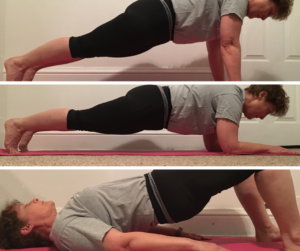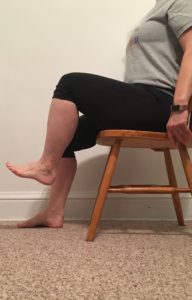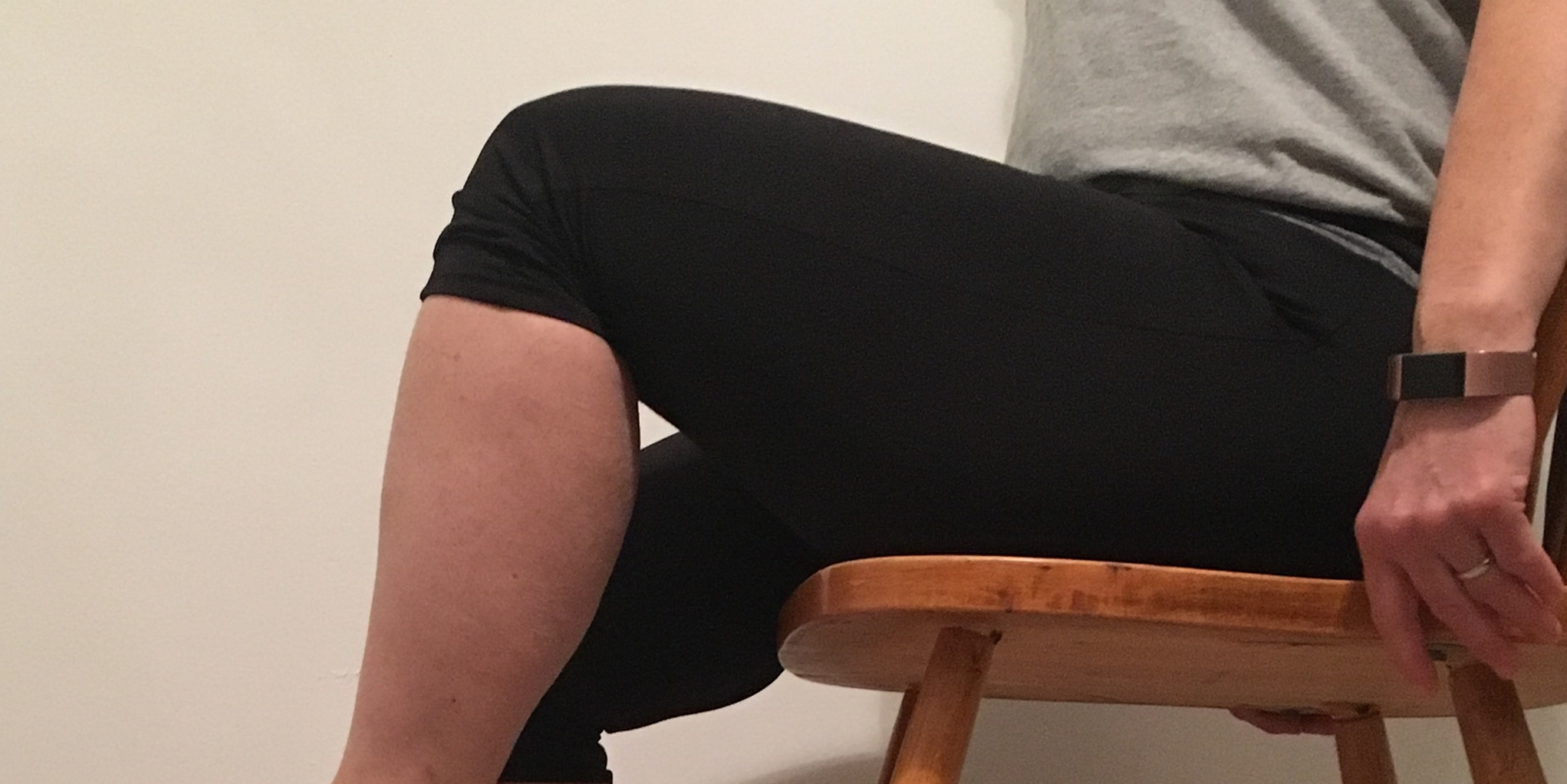Yeah, I know… And I’m pretty sure you know too. A stronger core is important. And it is especially important for a woman over 50!
When I first started working out, some instructors would talk about working abs, but others talked about the core. I thought it was the same thing for a long time.
Six pack abs is not something that I really had much of an interest in. However I suspected some of my back aches had something to do with weak stomach muscles. Actually stomach isn’t the right word, it’s not the right place. What I mean is the lower abdomen area, where I still had what I refer to as my “baby fat” (although those kids were well into college at that point!)
What exactly is the core?
Core actually refers to a large part of the body – not the legs and arms, but the glutes (butt), the pelvis, the abdomen, the lower back. I wouldn’t be surprised if it is nicknamed the “core” because is the main part of the body that everything else is attached to. When I think of an apple core, it’s the toughest part of the apple. Core is a foundation.
When I think about lifting a dumbbell weight, I realize that it is intended to work my arm, but I also have to be stabilized in the core to work those muscles. Skiing and biking works the legs, but having a strong core helps form and posture. This also helps with balance, to stay stable while skiing down the mountain or pedalling up a hill. Runners are often reminded to do cross training to strengthen their core muscles. There is no question that having strong glute muscles helps provide power when taking on a hill.
Why is toning the core so important?
Having a strong core isn’t just important for enjoying hiking, skiing, biking, running and a fun active lifestyle.
A stronger core means a stronger body and a better range of motion. It makes it possible to strengthen the rest of the body. Obviously, everything is connected. A stronger core means better balance, less likely to fall. A stronger core makes everyday tasks simpler. Just getting up from a chair, bringing in groceries, navigating an icy sidewalk all require balance and that means a stronger core.
Avoiding falls is top on everyone’s list. An unexpected fall can break bones, cause cuts and jar tendons, joints, ligaments and do unintended damage to a body! Do you know someone who suffered a fall recently? Maybe it was a slip on the ice, or missed a step? Tripped over a pet? Having a strong core gives you a better chance of not landing on the ground, staying stable, and keeping your balance when you’re knocked off kilter. We’ve all had a close call. A stronger core keeps us safe.
How can a strong core help reduce pain? I swear most of my back pain in my 40’s was from a weak core. Working your core helps to stretch and strengthen the lower back. One of the best ways to avoid back pain is to develop a strong core. (There are lots of causes and types of back pain, so consult a doctor and get the okay before you start any exercise program.)
Improving the muscles in your glutes and lower back helps to head off pain that comes from a strained back muscle when you tried to carry something too heavy.
Having a stronger core means having the strength when you need it. It gives you the strength to help move your body, but also basic things, like some boxes in the basement, furniture or groceries from the car into the house. We all know someone who tried to move something that seemed like an easy job, maybe something they had done when they were younger, but ended up straining a muscle or pulling something.
How to Start Strengthen the Core
You know your abilities. Don’t overdo it to try to get fit all in one day. Take it slow and begin with several exercises that you can master but also challenges you. If its been a while since you worked out*, you may want to start with some gentle yoga moves or seated exercises. If you’ve been working out and are ready to step things up for more challenge, progress slowly. Consistency over intensity!
 We’re working with a personal trainer to pull together an exercise program to focus on developing a strong core and will make that available here at Becoming Elli in the future. But meanwhile, here are three basic exercises to get started.
We’re working with a personal trainer to pull together an exercise program to focus on developing a strong core and will make that available here at Becoming Elli in the future. But meanwhile, here are three basic exercises to get started.

1) leg lifts – chair
2) planks – high and low
3) bridge
Important to remember:
Start easy and build up. Plan to repeat over time, after you get strength increase intensity, but build up the time and repetitions over days and weeks. Don’t try to get strong all at once.
If it’s been ages since you worked out, start with chair leg lifts, then move on to more advanced core exercises. Check with your doctor.
Use good form. Trying to condition and strengthen your body while using bad form or the wrong form won’t achieve the results you want… and worse, bad form could lead to injury. Don’t try to hold a pose so long that you sacrifice good form. It’s better to do few reps and less time than it is to use bad form.
Consider taking a gentle yoga class.
Be careful not to have loose abs and glutes when you do these exercises. You need to tighten the belly and lower abs. Think “squeeze” to tighten those butt muscles.
Proper form is really important You don’t want to have your butt in the air during a plank. You need to tighten your glutes (butt) and your abs during the plank. Start with the easiest plank on your hands, then move to elbows. Make sure your body is straight. Engage your glutes and abs (tighten your butt and lower belly) hold it for 30 seconds. Relax. build up to 45 seconds, one minute, two minutes.
Get a picture of yourself doing a plank. I know I found it eye opening!
What’s your favorite exercise to strengthen your core? Do you have a story about how your stronger core saved the day with a close call? Share it below in the comments or send me an email!
*even if it hasn’t been a while since you worked out, check in with a professional before starting an exercise routine.

Are forearm planks really harder than hand planks? Perhaps the forearm planks engage your core more? Anyway, just finished a 30 plank challenge from Pat Haupt. Starts with 20 seconds a day and progresses to 270 seconds. I did hand planks, but will give forearm planks a try now. Love your blogs…Thanks!
It’s funny you would ask that, because both types of planks feel about the same to me, but I think you’re right that forearm planks change the balance points. When I talked to a personal trainer about it, they smiled and suggested that I do “up/downs” – you know, where you go from low planks to high planks and try not to roll your hips.
Glad you’re enjoying the blog!
Here’s what I’ve been told about the two different kinds of planks. The ones on your hands, with straight arms, helps build muscle in your shoulders. I usually alternate between the two just to work on everything.
Have you ever done planks where you go from forearm planks to straight arm planks and then back? You just keep doing it; it’s a great workout.
If you doing a plank challenge, I always remind myself to take a break if necessary as the time increases.
Hey Karin, no they are not harder than hand planks. To me, they’re easier. The arm planks put more emphasis on your shoulders and the forearm plank moves that more to the core. I was always told to alternate them or to do the one that hits the muscles I want to hit.